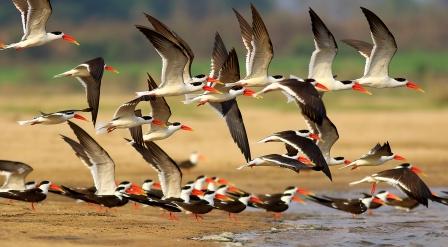Odisha Sun Times Bureau
Cuttack, Apr 7:
Another feather in the cap for Odisha birders. An exemplary and unprecedented citizen science initiative that will have far-reaching impacts on conservation of a threatened bird species, has taken wings in the field of ornithology in Odisha. Avid amateur bird watcher Sumant Rajguru who passionately scours the forests and habitats of the state on his bird watching sojourns stumbled onto the nesting site of the Indian Skimmer (Rynchop Albicollis) inside the Mahanadi river at Munduli in Cuttack, something that bird scientists and researchers had been searching for years now.

The Indian Skimmer is classified as vunerable by International Union for Conservation of Nature( IUCN) and BirdLife International which means there are only 6000-7000 of the species surviving in the wild. It is one of the least studied species of birds as its habitats are mostly remote and inaccessible, especially its breeding sites.

The Indian Skimmer, locally called Chirei, is a striking black and white water bird that has a bright orange colour scissor-like bill, with the lower mandible considerably longer than the upper one. This enables it to skim the surface of the river, pick out the fish with its lower mandible and then snap the bill shut to trap the fish inside and gulp it down. The species is seen all around the year in Odisha in a small belt of the Mahanadi river, though it is believed that there is also a shifting population of the species that comes to breed in these habitats after wintering in Bangladesh.

The Indian Skimmer is sighted in various riverine habitats of the state like Satkosia, Bhitarkanika, Nalabana, Dhamra, Hirakud and Munduli at Cuttack. It inhabits and breeds on sand-bars inside the river. Though the species has been observed to be mating in these habitats, there was no clue about where the birds were nesting in the state. Knowledge of breeding and nesting of a “Vulnerable” or “Threatened” species is extremely crucial from the viewpoint of conservation of the species, as adequate protection can then be provided to the nesting area to keep it free from any threats to the eggs, thereby allowing safe hatching, and consequent addition to the depleting numbers of the species.
In February 2016, Sumant noticed the activity of a couple of skimmers on a sand-bar inside the Mahanadi to the south of the Munduli bridge. Over the next few days he saw that the number of birds were increasing and on noticing the behavior of the congregating birds he realized that they could be in nesting mode. He informed his co-birder Panchami Manoo Ukil (founder of The Bhubaneswar Bird Walks) about the developments. They visited the site and were able to document nest-making not only by the Indian Skimmers but also by Black-bellied Terns (Endangered), River Terns (Near Threatened) and Small Pratincoles. On 22nd March they found eggs laid in the nesting scrapes in the sand and observed that the parent birds were sitting over the eggs.

In the last fortnight the number of skimmer nests in the sand-bar has been multiplying rapidly while the eggs of river terns have hatched. Keeping in mind the 21-26 days gestation period of the eggs of Indian Skimmer, it is likely that the first brood of Skimmer eggs would hatch by 21st April.
After more than 50 days of arduous field work that includes diligent documentation of sand, water, temperature, humidity and other environment factors, Sumant and his team are awaiting this final documentation of the breeding process which would be a fitting finale to this extremely critical finding. Meanwhile plant researcher and scientist Aaditya S. Kumar has been requested to identify the grass/plants/weeds/ on the sand-bar and in the adjoining stretches of water so that there is more relevant data available for research.

Sumant and Panchami have informed the Principal Chief Conservator of Forests/Chief Wildlife Warden Odisha about this important finding after which the Divisional Forest Officer and other officials have taken pro-active measure to keep the area protected from any interference by humans and cattle. Meanwhile Sumant continues his documentations of the species which might be the rarest documentations of the Indian Skimmer so far in the subcontinent. “As this is a rare event we have requested the Water Resource department not to release water in the Munduli barrage till the eggs are hatched,” said Siddant Das , Chief Wildlife Warden.
The astuteness of alert citizen scientists plays a major role in contributing to awareness and conservation. The discovery of a nesting site of three threatened species of birds is a very commendable achievement by an amateur birdwatcher. The effort deserves strong support by government and concerned agencies so that relevant conservation measures to monitor and protect the habitat are adopted to enable proliferation of fast-depleting species of avifauna.


Comments are closed.